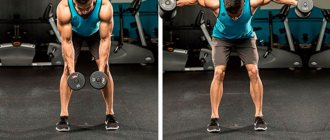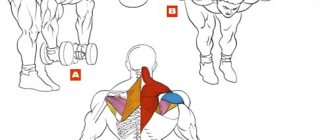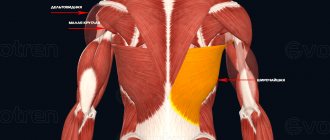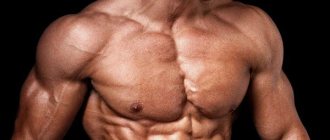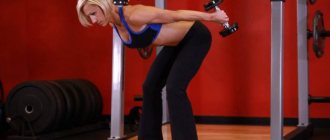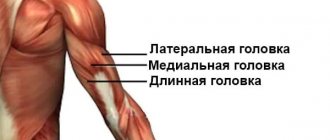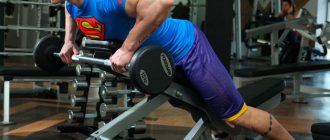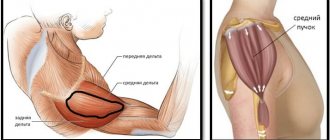The deltoid muscle forms the surface of the shoulder. Its tasks include flexion, extension of the arm, and abduction to the side. Conventional basic shoulder training only targets the anterior and middle bundles of the muscle, with the posterior being statistically the most likely to lag behind. Bent-over dumbbell flyes (swings) will help you use it. If you don't pay attention to the back of the deltoid muscle during exercise, your shoulders will appear disproportionate and your back will appear slouched.
- Purpose of the exercise
- Muscles involved
- Benefits of Exercise
- Options for performing bent over raises
- Standing dumbbell raises
- Video: Bent over dumbbell swings
- Seated dumbbell raises
- Video: Dumbbell flyes for the rear deltoid while sitting on a bench
- Reverse dumbbell flyes lying on an incline bench
- Video: How to pump up your shoulders. Dumbbell flyes lying on a bench
- Useful tips and tricks for doing the exercise
What does the exercise do?
The bent over arm extension engages all three heads of the triceps: long, lateral and medial.
The emphasis of the load in the exercise falls on the triceps.
The exercise can be done by men and women. This workout is light on shoulder and core strength and only targets the triceps.
- Dumbbell curls can be recommended for those who need to work on triceps symmetry. By performing different numbers of repetitions with your right and left hands, you will gradually equalize their volume.
- The exercise can also be performed by beginners who are just starting to train their upper body. It will help develop basic triceps strength to progress to complex training.
- The exercise is suitable for women who have developed “wings” on their shoulders - loose skin that appears after losing weight or as a result of natural age-related changes.
- Triceps exercises such as reverse push-ups or close-grip bench presses put stress on the wrists and can cause pain. When bending your arms with dumbbells, your hands are in a natural position.
Correct breathing when exercising with dumbbells
Proper breathing helps with training, ensures maximum efficiency and minimizes the risk of injury. The basic law of breathing is that effort is made while exhaling. During the exhalation process there should be maximum muscle tension. Inhalation is done with minimal effort.
Breathing at the level of the reflex affects muscle tension, and its delay creates the greatest point of tension.
The principle of the correct breathing process when doing presses:
- In a lying position. Squeezing the dumbbells up – exhale. Lowering your arms with weights onto your chest – inhale.
- Sitting or standing position - when moving away from yourself - exhale.
The principle of proper breathing during biceps exercises:
- when muscles contract, exhale;
- straightening your arms, lowering your chest – inhale.
Execution technique
To complete the exercise you will need:
- one or two dumbbells of suitable weight;
- a horizontal bench or other surface to support the knee.
You can perform the exercise without a bench. Let’s discuss this separately, as a variation of bent over arm extension.
Extension technique.
To avoid confusion in terminology, it should be mentioned that the shoulder is the part of the arm above the elbow, and the forearm is from the elbow to the hand.
Initial position:
- Place one knee on the bench.
- Place your hand on the same side of the bench for body support and balance.
- Lean forward slightly so that your body is parallel to the floor. The spine should be straight. The neck is aligned with the level of the back. The gaze is directed forward. The stomach is pulled in, the abdominal muscles are tense.
- Place your other leg on the floor for support.
- Take the dumbbell in your free hand and bend your elbow at a right angle. This is the starting position.
Movement:
- Raise your bent elbow until your shoulder is parallel to the floor. The forearm with the dumbbell is directed downward. Take a breath.
- Exhaling, bend your elbow straight back until your arm is completely straight. The triceps at this moment should be as tense as possible, and the position of the shoulder should be fixed.
- Hold the dumbbell in your straight hand for a few moments.
- As you inhale, smoothly return your hand to the starting position.
- Repeat as many times as necessary and switch sides.
The main technical point is that the shoulder remains absolutely motionless throughout the entire exercise. Movement occurs only at the elbow joint.
Beginners often swing the dumbbell, causing inertial shoulder abduction and body swing. This is wrong and even dangerous. Movements must be clear, rhythmic and controlled. Also remember to breathe evenly and focus on contracting your triceps as you extend your arm.
Standing extensions without a bench
You can skip the bench and train both arms at the same time. In this case, the exercise is performed in a standing position with the body tilted forward.
- Hold a dumbbell in each hand.
- Bend your knees slightly and, keeping your back straight, lean your body forward.
- Bend your elbows at right angles and move your shoulders back.
- Extend your arms back, keeping your shoulders in a fixed position.
Triceps training in a standing position.
Working muscles
Before performing dumbbell flyes while lying down, the athlete needs to know which muscles work.
Basic
This isolated exercise trains the chest muscles, because in the process they are stretched in length and give the muscle fibers a significant distance to contract. This is precisely the reason for the growth of muscle mass, because the more the muscles contract, the more fibers work. When performing exercises, the practitioner should feel the chest stretching. This is not the case when you need to lift heavy weights and strive to set records; it will be more effective to work on technique and concentrate on training a specific muscle group and how you feel. During training, tears appear in the muscle fibers; their recovery always takes time. When an athlete rests, the amino acids and proteins that are included in the products envelop the damaged fibers, as a result of which they are not only restored, but also become more voluminous. The recovery process is fastest in the triceps, slowest in the back.
Did you know? Ronnie Coleman (bodybuilding legend, eight-time winner of the Mr. Olympia competition) used dumbbells weighing 30 kg during pumping training.
If the main load falls on the central part of the pectoralis major muscle, then the anterior deltoids, serratus anterior and coracobrachialis muscles become the assistant muscles. Also a pleasant addition will be the effect of the exercise on the formation of correct posture, the development of chest width and high-quality stretching of the back.
Important! You cannot lower your legs to the floor; you need to leave them bent at the knee joints so that your feet rest against the edge of the bench. This is necessary in order to avoid involuntary arching in the lower back.
Such a deflection, even if insignificant, will remove the load from the pectoral muscles and take it to the lower back, which will significantly reduce the effectiveness of the exercise.
Recommendations for implementation
In order for the arm extension to give maximum results, follow the recommendations below when performing the exercise.
- When performing the exercise on a bench (when the body is parallel to the floor), the elbow should always be at the same level as the shoulder joint.
- The starting position is a right angle between the shoulder and forearm.
- The forearm cannot be swung like a pendulum. Pulling your arm with a dumbbell back under the influence of inertia will not give the expected result.
- It is not recommended to use very heavy dumbbells.
Arm extensions do not involve the use of heavy weights, since to perform correctly and effectively you need to keep your shoulder in a fixed position.
A medium and large number of repetitions are performed in several approaches (2-3 sets of 8-12 repetitions).
The main muscles involved in the exercise “Lying Dumbbell Raises”
| Muscle | Location | Muscle work in exercise |
| Pectoralis major muscle | Upper chest | Brings the elbows closer together (shoulder adduction); moves the upper arms forward in relation to the body (shoulder flexion) |
| Anterior head of deltoid | Covers the shoulder joint from the front and partly from the top | Move the upper arms forward relative to the body (shoulder flexion) |
| Serratus anterior muscle | Covers the side of the ribs, below the armpit | Helps in moving the shoulder blades away from each other: pulls the shoulder blades forward and outward |
| Coracobrachialis muscle | Inner section of the upper arm at the shoulder joint, attached to the edge of the shoulder blade | Helps bring the elbows together (shoulder adduction) and move them forward (shoulder flexion) |
The most popular mistake
A common mistake when performing bent-over dumbbell extensions is unconsciously lowering your elbows.
- As the elbow drops, the range of arm extension decreases. At the same time, the tension in the triceps at the end point of extension decreases.
- The person tries to compensate for this lack of amplitude by bending the arm more than the exercise requires.
Sometimes the cause of elbow drop can be a dumbbell that is too heavy. Choose a different weight at this stage of training.
Training program
The exercise is extremely effective and efficient. But you cannot use it as a base in your training. It is better to include it in the training after the basic ones (barbell and dumbbell presses on a bench). The fly is effective precisely at the end of the workout, when heavy weights have been worked and the muscles are noticeably warmed up. You need to perform approximately 3-4 sets of 8-12 repetitions.
Did you know? Haltares is what dumbbells were called in Ancient Greece. They were used not only during weight lifting competitions, but also to improve the quality of long jumps. By throwing dumbbells back in a three-meter jump, it was possible to jump 17 cm further.
Turning your rear delts to stone
In this article, I'll take you on a tour of rear delt exercises and describe seven variations of the rear delt raise.
Each of the seven movements has its own characteristics, which means there's always room for some variety in your workouts.
If you've found yourself stuck or hit a training plateau, this kind of variability may be exactly what you're missing.
Don't think that this advice only applies to the rear deltoids. By and large, to optimize muscle growth, you must know several variations of each exercise and include them in your training at some point. Having mastered this simple science, you will become not only the fastest bodybuilder in the gym, but also the biggest!
Options for performing overhead dumbbell extensions
I showed you my favorite and, in my opinion, the most effective form of performing this exercise, but there are also other variations that you can use, for example, for variety or due to anthropometric characteristics (for example, sharp pain when performing the first variation) :
- Extension of two dumbbells from behind the head while sitting.
- Standing arm extension.
- Alternately extend the dumbbell behind the head with each arm while standing or sitting.
- Crossover extension of the arms behind the head.
I see no point in describing the technique of each of these variations, since, in essence, it will be the same.
